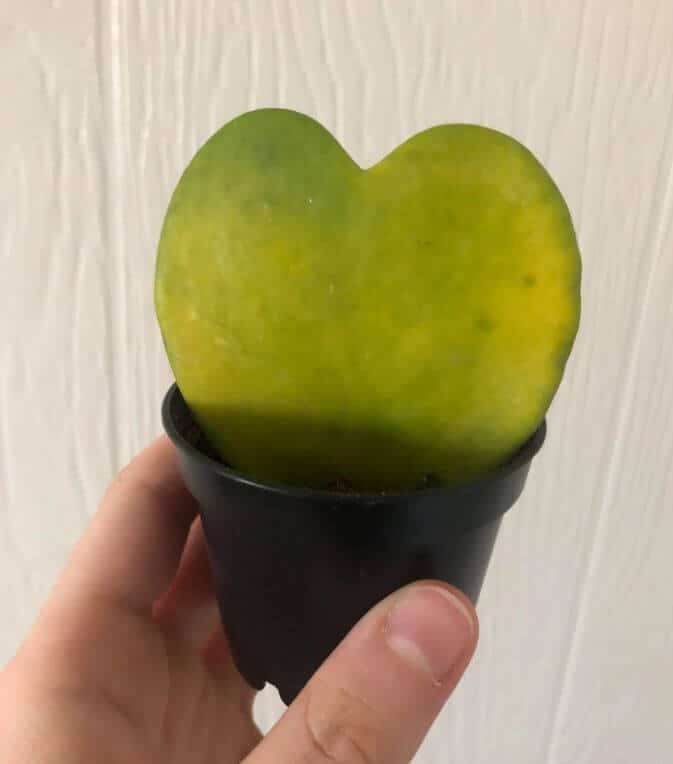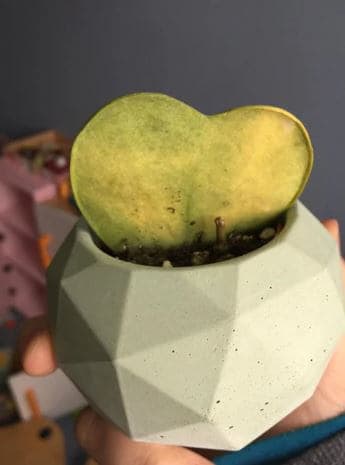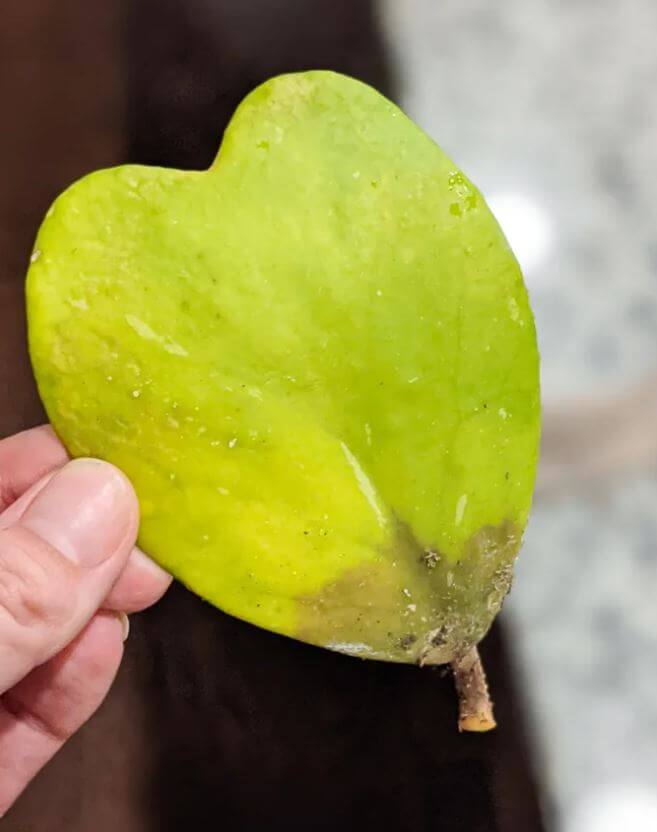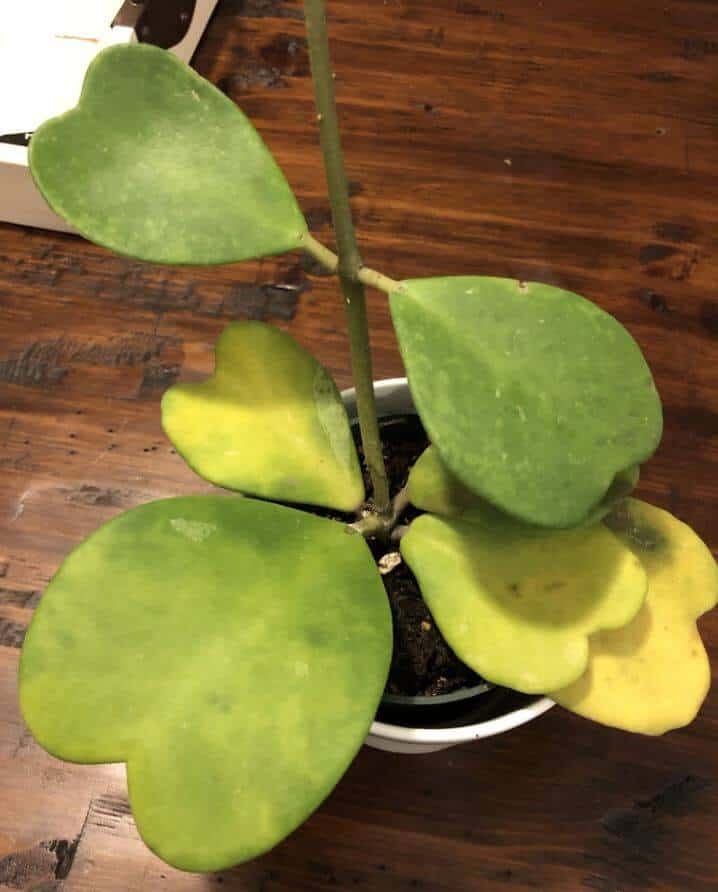Last Updated on June 19, 2023 by a Friendly Gardener
When plant foliage turns yellow, it usually means there’s a problem. But to properly care for a distressed plant, it’s important to identify the underlying cause before opting for treatment. Once you know the reason for your Hoya Heart’s yellowing leaves, you can attempt to fix the problem.
A Hoya Kerrii is generally available in nurseries or garden centers as a single heart-shaped leaf in a container. After several years, other leaves will appear on a stem. As succulents, hoya plants store water in foliage making the somewhat drought-tolerant. Yet, even though they are easy to care for, there are still issues that can afflict them.
Hoya Heart plant leaves turning yellow can be due to improper care concerning light levels, watering, and fertilizing. Bad water quality, pest infestations, a lack of nutrients, or environmental temperature can also negatively affect this succulent.
Why Is My Hoya Heart Turning Yellow?

Often it may not be simple to determine the cause, but here we examine several of the most common causes of this heart succulent turning yellow.
-
Improper Environmental Temperatures

Hoya heart plants do not like cool temperatures or drafts for that matter. Drafts can dry foliage causing it to be yellow. Hoya heart plants should not be placed in locations with temperatures below 50°F. Colder temps stress this succulent and can cause yellowing foliage.
What to Do
Keep your plant away from air conditioning vents or drafty windows, doorways, or corridors. If cultivating outdoors, bring the plant inside when temperatures drop to 50°F or below.
-
Improper Light
Plants use photosynthesis for nourishment by converting oxygen, light, and water into much-needed energy for growth and survival. If your plant receives insufficient or excessive light, its health will suffer.
Intense, direct UV rays received through direct light can scorch it. This can happen easily if the plant is left outdoors too long. If left unattended, dry brownish streaks may follow and the plant might go limp.
Hoya plants should also not be placed in an environment that is too dark. This will inhibit photosynthesis and disturb the production of chlorophyll. It is the lack of chlorophyll that turns leaves yellow.
What to Do
Move your Hoya heart plant, placing it in a spot with partial shade with bright indirect light. If you are cultivating your plant outside, make sure that it is not exposed to direct light. Place it next to a taller plant or ensure that it has some shade. If your plant experiences sunburn, remove the affected part to divert energy to healthy foliage. Artificial indoor lighting is another option.
-
Low Humidity
As succulents, these plants like warm climates and generous humidity. If you live in an arid climate, you can place your plant in a bathroom or kitchen where humidity levels are a bit higher.
What to Do
Consider using a space humidifier or grouping plants to create a microclimate.
-
Nutrient Deficiencies

Occasionally a Hoya heart plant turning yellow is due to your Hoyakerrii suffering from a nutrient deficiency of potassium or nitrogen. This can be caused by old soil, a lack of fertilization, or excessive fertilization.
What to Do
If the soil in the pot is old, repot your plant with fresh soil formulated for succulents. Only fertilize your Hoya during its growing season which is spring and summer. Use a liquid fertilizer for houseplants that are rich in potassium and nitrogen. Make sure to dilute it before applying it to prevent burning roots.
-
Overwatering

If the soil bed is still damp, you should wait to water your plant. This is perhaps the most common reason that hoya kerrii yellow leaves appear. With excessive watering, soil and roots will not be able to aerate properly. Roots will also be unable to absorb vital nutrients. Only water this plant when the soil bed is dry.
What to Do
If your Hoya heart plant has been sitting in wet soil, it needs to be repotted immediately. Repot it in a pot with fresh soil formulated for succulents. If the roots show root rot, these infected roots should be trimmed off. Rinse healthy roots and treat them with a fungicide. After repotting, water sparingly and wait until the soil bed is completely dry before watering again. With multiple leaf hoya heart plants, prune any discolored foliage.
-
Pest Infestations

The Hoya kerrii is generally not susceptible to pest infestations, but it is not entirely immune. Pests can impede nutrients from moving through your plant which will lead to foliage discoloration and yellowing. When the hoya is in a spot that is excessively damp or dry, it is the ideal environment for pest infestations. Pests to watch for include:
– Mealybugs
These bugs appear like cottony deposits on stems and leaves. They are prolific breeders so they will quickly infest other houseplants. If mealybugs take up residence, act quickly.
– Scales
These look like dark brown or black oval-shaped lumps that do not move.
– Spider mites
These are minuscule reddish or brown spiders. Telltale signs include webbing found on the undersides of leaves.
What to Do
If your Hoya shows signs of a pest infestation, isolate it as pests spread quickly to other houseplants. Clean foliage with a mild soap and water solution. After cleaning your plant’s leaves, treat them with neem oil. You may also want to repot in case any insects are nestling in the soil bed.
-
Underwatering
Although a Hoya heart is drought tolerant, if you have forgotten to water and the soil bed is bone dry, this would explain yellowing leaves.
What to Do
Water your plant allowing it to drain. It should revive quickly. In the case of multiple leaves, yellow leaves should be pruned.

